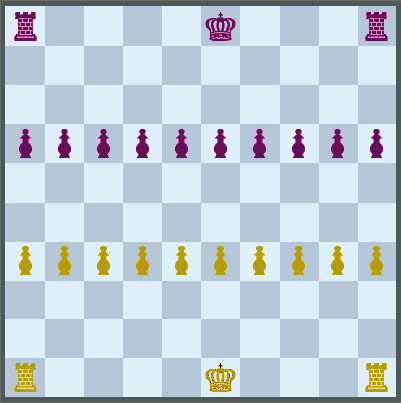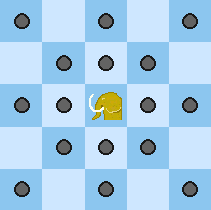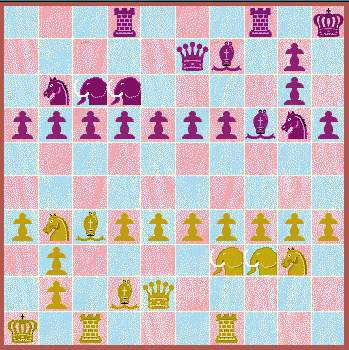

Introduction
The objective in Mammoth Chess is checkmate. The name not only reflects on the Mammoth piece, but also on the size of the board, which is 10x10. Pieces move as in orthodox chess, with the exception of the additional piece, the Mammoth. It jumps one or two steps diagonally or orthogonally. It has roughly the same value as Rook + Pawn. The Mammoth jump complements the jump move of the Knight. A Mammoth, together with a King, can give mate to a lonely King. The pawns move as in orthodox chess, but have no initial double move. As the pawns are all located on the fourth rank, they can reach the fifth rank immediately anyway. When castling, the King jumps three squares instead of two. Promotion rules are the same as in orthodox chess (with the addition of the Mammoth).
 The Mammoth jumps one
or two steps diagonally
or orthogonally.
The Mammoth jumps one
or two steps diagonally
or orthogonally.
In the first phase the players take turns to drop pieces on the board, either behind the pawn chain, or on a friendly pawn. In the latter case the removed friendly pawn must immediately be relocated to another empty position, that is, somewhere on the second or third rank. The two Bishops must be dropped on different colours. The King and Rooks are placed on their regular squares. They are immobile until all pieces have been dropped. After all the pieces have been dropped the play begins.
Always give your King a protected position, preferably near the corner. You can relocate the pawns so that they protect the King. Remember that relocated pawns have no initial double move, so it takes longer to activate such pawns. In the opening phase, the same pawn can be relocated several times, by dropping pieces on it. Keep the pawns in the centre, because center pawns are valuable. Look for ways to exchange lower valued pieces for larger valued ones. The Mammoth equals Rook + Pawn. Rook and Mammoth cooperate effectively in the attack on the enemy king.
There exist two alternative variants of Mammoth Chess. In the first, all pieces, except pawns, are exterior. In this case castling doesn't exist, and the Rooks must be dropped on the first rank (see image below). In another variant Crabs take the place of the pawns. The Crab moves as a pawn, but if its northward movement is blocked it has two extra moves: two forward knight jumps to empty squares only (east-north-east and west-north-west). It adds zest to the game, creating many tactical possibilities.
 Example of opening position after all pieces have been dropped. Pawns have been relocated near the king to provide safety. There are good opportunities for pawn storms on either wing. Alternatively, the battle will go on in the centre.
Example of opening position after all pieces have been dropped. Pawns have been relocated near the king to provide safety. There are good opportunities for pawn storms on either wing. Alternatively, the battle will go on in the centre.
Mammoth Chess was invented and implemented by undersigned, April 2006. Inspirational sources are Swedish Chess and Grand Chess. The Mammoth piece (also called Mastodon) is not entirely new. Under other names it appears as the queen analog in Grand Shatranj and as the royal piece in Atlantean Barroom Shatranj. In EV Greenwood's Renniassance Chess (not misspelt) from 1980, the piece is named Squire. The Scorpion pawn derives from Scorpion Chess.
Discussion
Chess variants featuring big boards have been invented before, most notably Tamerlane Chess, allegedly invented by Timur Lenk, C. Freeling's Grand Chess, and Capablanca's chess, invented by the former world champion. Mammoth Chess differs significantly from these previous variants, not only in the pieces employed. The initial drop move, deriving from Burmese Chess, allows great strategical freedom. The king can achieve a more protected position than in Grand Chess, while the pawns can be relocated to protect the king. This significantly alters the balance between strategy and tactics. Opening play does not rely on concrete variants but rather on principles and favoured piece setups. Consequently the game will never be bogged down by opening theory, as the case is in today's orthodox chess. The Mammoth is a piece which is easily mastered, very suited for the congested environment in a game with many pieces and pawns.
(Don't miss my other chess variants.)
You can download my free Mammoth Chess program here (updated 2007-05-17), but you must own the software Zillions of Games to be able to run it.
© M. Winther 2006